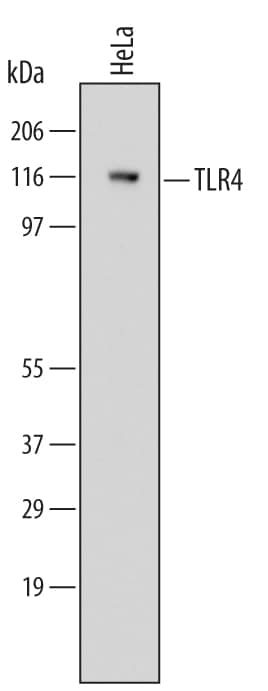Human TLR4 Antibody Summary
Glu24-Lys631
Accession # O00206
Customers also Viewed
Applications
Please Note: Optimal dilutions should be determined by each laboratory for each application. General Protocols are available in the Technical Information section on our website.
Scientific Data
 View Larger
View Larger
Detection of Human TLR4 by Western Blot. Western blot shows lysates of HeLa human cervical epithelial carcinoma cell line. PVDF Membrane was probed with 2 µg/mL of Mouse Anti-Human TLR4 Monoclonal Antibody (Catalog # MAB14782) followed by HRP-conjugated Anti-Mouse IgG Secondary Antibody (Catalog # HAF007). A specific band was detected for TLR4 at approximately 120 kDa (as indicated). This experiment was conducted under reducing conditions and using Immunoblot Buffer Group 1.
Preparation and Storage
- 12 months from date of receipt, -20 to -70 °C as supplied.
- 1 month, 2 to 8 °C under sterile conditions after reconstitution.
- 6 months, -20 to -70 °C under sterile conditions after reconstitution.
Background: TLR4
TLR4 is a 100 kDa type I transmembrane glycoprotein that belongs to the mammalian Toll-Like Receptor family of pathogen pattern recognition molecules. MD-2, also known as ESOP-1, is a 25 kDa secreted protein that is required for TLR4-mediated responses to bacterial lipopolysaccharide (LPS) (1‑3). The human TLR4 cDNA encodes an 839 amino acid (aa) precursor that contains a 23 aa signal sequence, a 608 aa extracellular domain (ECD), a 21 aa transmembrane segment, and a 187 aa cytoplasmic domain. TLR4 contains 21 leucine rich repeats in its ECD and one cytoplasmic Toll/IL-1 receptor (TIR) domain (4). The ECD of human TLR4 shares approximately 25% aa sequence identity with other TLRs and 60%‑74% aa sequence identity with bovine, equine, feline, mouse, rat, and porcine TLR4. The human MD-2 cDNA encodes a 160 aa precursor with an 18 aa signal sequence (5). Human MD-2 shares 20% aa sequence identity with MD-1 and 62%‑64% aa sequence identity with bovine, mouse, and rat MD-2. MD-2 associates with TLR4 on monocytes, macrophages, dendritic cells, and B cells (5‑7). MD-2 expression is required for cell surface localization of TLR4 and for optimal LPS-induced TLR4 signaling (7, 8). MD-2 also forms soluble disulfide-linked homo-oligomers which can interact with TLR4 (6). Through a domain separate from its TLR4-binding domain, MD-2 extracts LPS from circulating CD14-LPS complexes and carries the LPS into a ternary complex with TLR4 (9‑11). The interaction of MD-2/LPS with TLR4 induces receptor oligomerization and the triggering of an inflammatory response (12). Increased levels of plasma MD-2 in septic shock patients sensitizes MD-2 non-expressing epithelial cells to LPS and promotes widespread tissue inflammation (13).
- Gangloff, M. and N.J. Gay (2004) Trends Biochem. Sci. 29:294.
- Palsson-McDermott, E.M. and L.A. O’Neill (2004) Immunology 113:153.
- Miyake, K. (2004) Semin. Immunol. 16:11.
- Medzhitov, R. et al. (1997) Nature 388:394.
- Shimazu, R. et al. (1999) J. Exp. Med. 189:1777.
- Visintin, A. et al. (2001) Proc. Natl. Acad. Sci. USA 98:12156.
- Akashi, S. et al. (2000) J. Immunol. 164:3471.
- Nagai, Y. et al. (2002) Nat. Immunol. 3:667.
- Re, F. and J.L. Strominger (2003) J. Immunol. 171:5272.
- Kennedy, M.N. et al. (2004) J. Biol. Chem. 279:34698.
- Gioannini, T.L. et al. (2004) Proc. Natl. Acad. Sci. USA 101:4186.
- Saitoh, S. et al. (2004) J. Endotoxin Res. 10:257.
- Pugin, J. et al. (2004) Blood 104:4071.
Product Datasheets
Citations for Human TLR4 Antibody
R&D Systems personnel manually curate a database that contains references using R&D Systems products. The data collected includes not only links to publications in PubMed, but also provides information about sample types, species, and experimental conditions.
2
Citations: Showing 1 - 2
Filter your results:
Filter by:
-
An adapted protocol to derive microglia from stem cells and its application in the study of CSF1R-related disorders
Authors: Dorion, MF;Casas, D;Shlaifer, I;Yaqubi, M;Fleming, P;Karpilovsky, N;Chen, CX;Nicouleau, M;Piscopo, VEC;MacDougall, EJ;Alluli, A;Goldsmith, TM;Schneider, A;Dorion, S;Aprahamian, N;MacDonald, A;Thomas, RA;Dudley, RWR;Hall, JA;Fon, EA;Antel, JP;Stratton, JA;Durcan, TM;La Piana, R;Healy, LM;
Molecular neurodegeneration
Species: Human
Sample Types: Whole Cells
Applications: Flow Cytometry -
HMGB1 as a potential biomarker and therapeutic target for severe COVID-19
Authors: R Chen, Y Huang, J Quan, J Liu, H Wang, TR Billiar, MT Lotze, HJ Zeh, R Kang, D Tang
Heliyon, 2020-12-07;6(12):e05672.
Species: Human
Sample Types: Tissue Lysates
Applications: Western Blot
FAQs
No product specific FAQs exist for this product, however you may
View all Antibody FAQsReviews for Human TLR4 Antibody
Average Rating: 4 (Based on 1 Review)
Have you used Human TLR4 Antibody?
Submit a review and receive an Amazon gift card.
$25/€18/£15/$25CAN/¥75 Yuan/¥2500 Yen for a review with an image
$10/€7/£6/$10 CAD/¥70 Yuan/¥1110 Yen for a review without an image
Filter by:






















